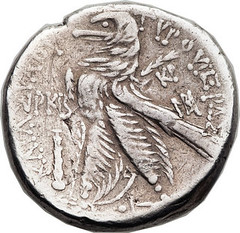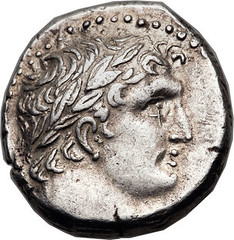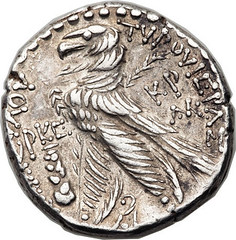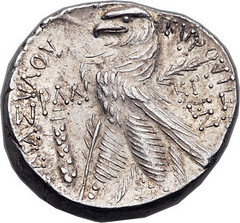
PREV ARTICLE
NEXT ARTICLE
FULL ISSUE
PREV FULL ISSUE
CHRISTUS VITAE COLLECTION OF SHEKELS FROM THE LIFETIME OF JESUSHeritage is selling an interesting and challenging collection of ancient coins the evening of Monday, January 5, 2015, at the
Waldorf Astoria Hotel in conjunction with the New York International Numismatic Convention. The collection of 38 shekels of Tyre, all struck in
consecutive years spanning the lifetime of Jesus of Nazareth, was assembled by Frank L. Kovacs of Corte Madera, California, over about a 25-year
period (and without the benefit of a Whitman folder with one hole for each date!). Here are excerpts from the catalog description. -Editor
PHOENICIA. Tyre. 126/5 BC-AD 65/6. Collection of 38 AR shekels spanning the lifetime of Jesus Christ, circa 5 BC – AD 33/4. Dated from Civic Year 122 (5/4 BC) to Civic Year 159 (AD 33/4). All of general type bust of Melqart right, wearing laurel wreath, lion-skin around neck / TYPOY IEPAS KAI ASY?OY, Eagle standing left on prow, palm frond over wing; to left Civic Year date (in Greek letter-numerals) above club; to right, KP above monogram; Phoenician letter indicating officina between legs. Individual dates, weights are provided below. Attributions are by Roman Provincial Coins Vol. I and Vol. I supplement, and by Dated Coins of Antiquity Vol. 1 (Ed Cohen-CNG, 2011) and DCA Supplement: Shekels of Tyre (Cohen-CNG, 2014). Rarity ratings are according to DCA 1 and are as follows: C = Thousands of known specimens; S = 500 to 2,000 known specimens; R1 = 25 to 500 known specimens; R2 = 2 to 25 known specimens; R3 = 1-2 known specimens; U = Unreported. DCA Supplement: Shekels of Tyre updates the rarity assessment (at least one example was found for most of the issues listed as U in Volume 1). The number of specimens cited in both RPC and SCA supplement are provided when available.  
Date PKB, Year 122 (5/4 BC)  
Date PKE, Year 125 (2/1 BC)  
Date P?A, Year 131 (AD 5/6) This extraordinary set of 38 dated shekels of Tyre, the main silver coinage of the Holy Land in New Testament times, spans the putative lifetime of Jesus of Nazareth and is the only collection of its type ever assembled. Hence we are justified in calling it "The Collection of a Lifetime." The collection was assembled by noted numismatist and antiquarian Frank Kovacs of Corte Madera, California over a 25-year period from 1990 to the present. Widely known as an expert on dated coinages of the Classical East (including Armenia, Judaea, Syria and Phoenicia), Frank's extensive contacts provided him the opportunity to acquire several newly discovered dates that still survive only singly or in tiny numbers (fewer than five known examples). At least one coin in the collection (number 33, dated Year 154 / AD 28-29), is thought to be unique. Thus this collection would be impossible to duplicate until more examples come to light. The Lifespan of Jesus:
Establishing the actual lifespan of Jesus is thus an uncertain exercise at best, as the Gospel accounts contain no detailed time line and the actual dates that are mentioned are frequently contradictory. However it is possible to set the broad goalposts between which Jesus must have lived, using the earliest widely accepted year for his birth, 5/4 BC, and the latest likely date for his Crucifixion, AD 33/4. Shekels of Tyre:
Lacking a silver currency of its own, the newly independent kingdom of Judaea came to accept the use of Tyrian silver as the main coin of the realm. Tyrian shekels and half-shekels were the only coins acceptable as tithes and payments to the Temple in Jerusalem, which was vastly expanded by Herod the Great (37-4 BC). This situation maintained after the Romans gained direct control of Judaea after Herod's death. After 20/19 BC, the style and fabric of Tyrian coinage changed markedly, with the coins becoming smaller and thicker, and the letters KP were added to the reverse control marks. The noted Israeli numismatist Ya'akov Meshorer proposed that these later shekels were actually minted in Jerusalem rather than Tyre, based on hoard evidence that the coins circulated far more heavily Judaea than in neighboring Phoenicia. While this view is not widely accepted, it is clear these later shekels were minted primarily to meet burgeoning demand in Judaea and surrounding regions. Edward Cohen, author of "Dated Coins of Antiquity," notes that the date form of the later shekels (consistently reading left-to-right) differs from the earlier issues and indicates a different mint in the southern Levant. These "KP" shekels were evidently minted more sporadically, and in smaller numbers, than earlier issues and are generally much rarer today; in fact coins are unknown for several of the years between 20 BC and AD 66, when their issue ceased. Other years are known from only a single specimen or a handful of examples. The Tyrian shekel features prominently in many Gospel accounts, most notably the scene in which the Apostle Judas betrays Jesus to the Temple authorities and is "covenanted" with "30 pieces of silver." These were certainly shekels of Tyre. In another scene (Matthew 17:24-27), Jesus plucks a shekel from the mouth of a fish to pay his Temple tax. The famous incident where Jesus attacks the "money changers" in the Temple courtyard likely resulted in many Tyrian shekels flying about, as this was the currency into which visitors were changing their own native coins. Since Tyrian shekels were the only large silver coins to circulate heavily in the Judaea, Samaria, Galilee and the Decapolis, the very regions Jesus of Nazareth frequented during his itinerant ministry, the question must be asked: What are the chances that Jesus himself, or one of his disciples, or one of the other figures mentioned in the Gospels, actually touched or held one of the coins in this collection? That Jesus or any one particular historical figure ever handled one of these coins is unknowable and unprovable, but it's that
possible connection that fascinates collectors. I'd never heard of a collection like this being assembled before. Congratulations to the
collector, Frank Kovacs. -Editor
To read the complete lot description, see:
 Wayne Homren, Editor The Numismatic Bibliomania Society is a non-profit organization promoting numismatic literature. See our web site at coinbooks.org. To submit items for publication in The E-Sylum, write to the Editor at this address: whomren@gmail.com To subscribe go to: https://my.binhost.com/lists/listinfo/esylum All Rights Reserved. NBS Home Page Contact the NBS webmaster 
|